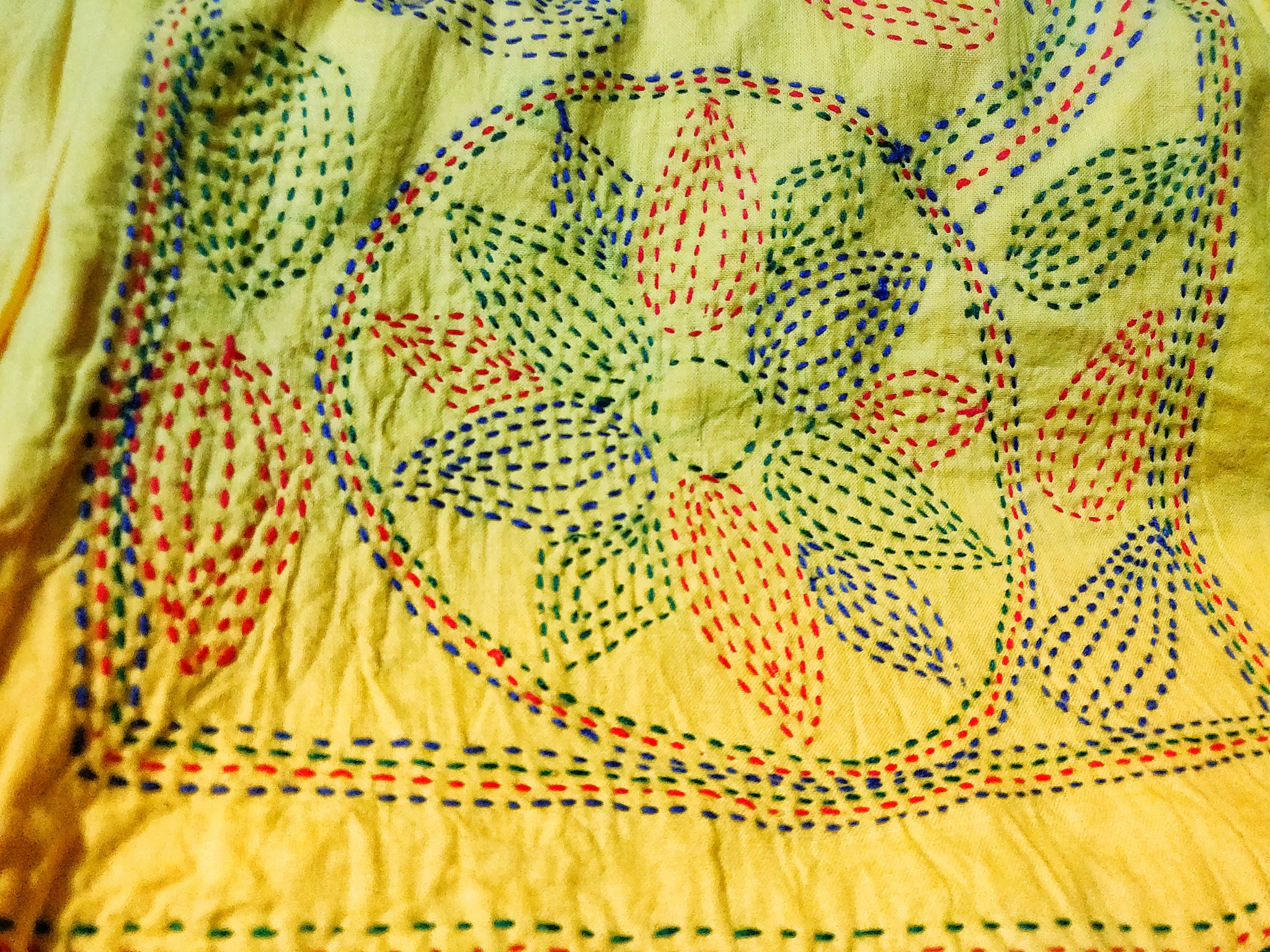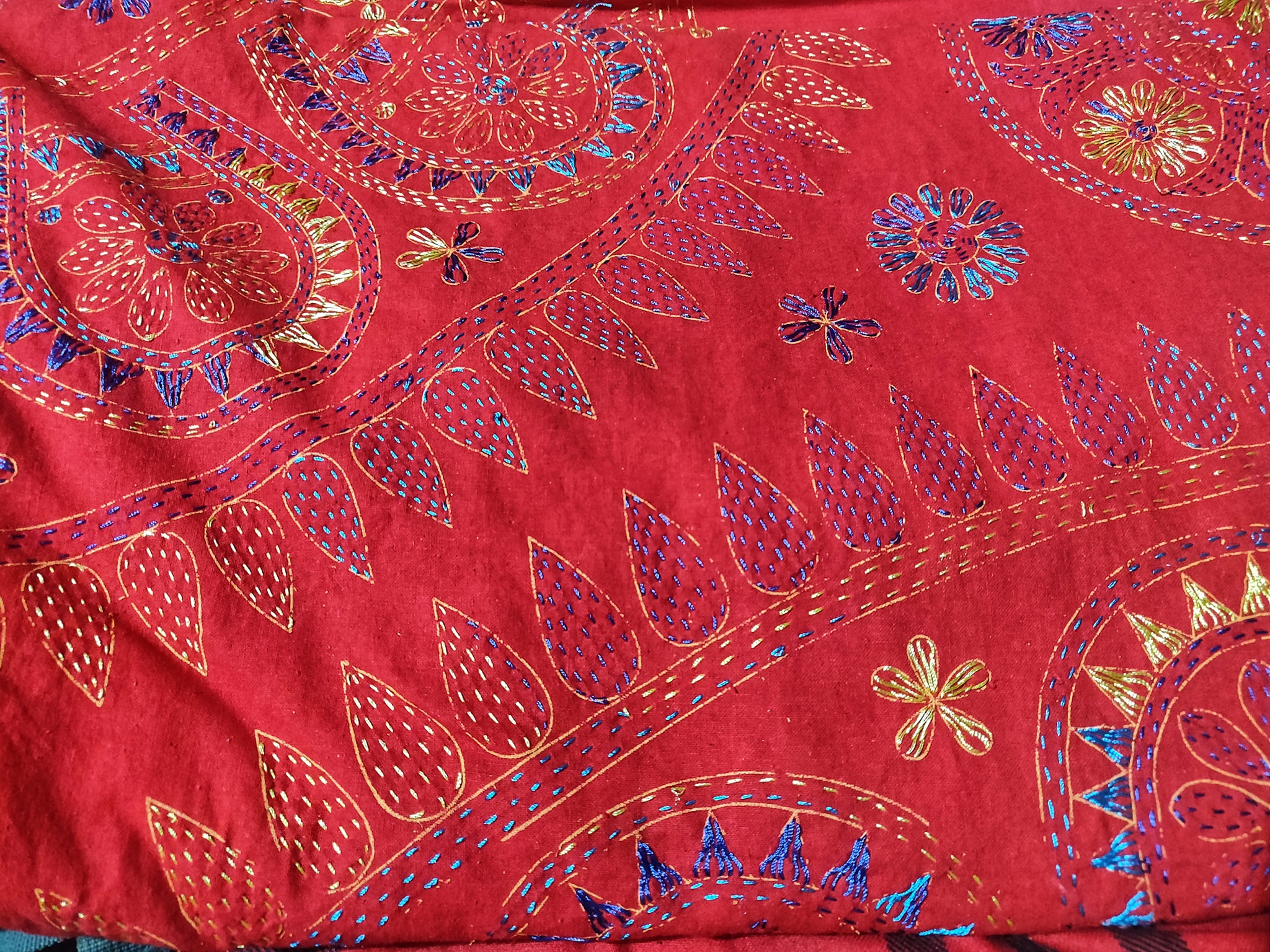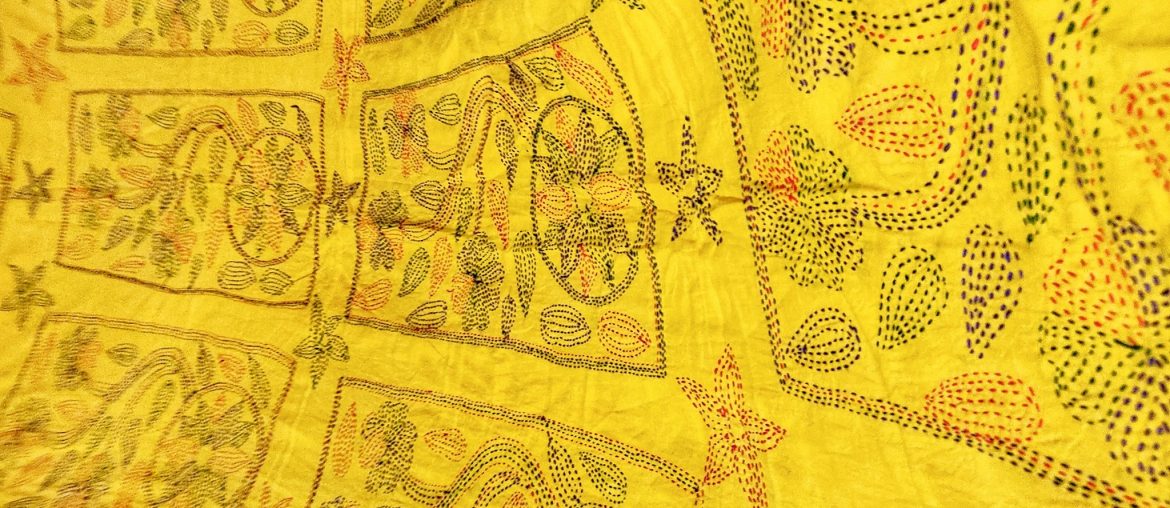Jasim Uddin’s famous verse narrative, ‘Nakshi Kanthar Maath (The Field of Embroidered Quilt)’, is not a fantasy based in a faraway land. It tells the story of how the women of rural Bengal wove beautiful embroidered quilts for their loved ones. Fond memories of loved ones living in foreign lands were imbued in every weave of the Nakshi Kantha. Many might have unfulfilled wishes of gifting that handwoven Nakshi Kantha to their true love, just like Shaju in the poem.
Is it stories such as this, or the intricacy of the weaves that made the Nakshi Kantha into an icon in Bengali folklore? It is true that such tales have endeared us to the humble Nakshi Kantha. But the embroidery of the Nakshi Katha itself also paints a picture of life in rural Bengal. We cannot ignore the artistry that goes behind the creation of the Nakshi Kantha. And in recent years, the Nakshi Katha has seen a resurgence. In today’s article, we will look at the story behind the iconic Nakshi Kantha.
The Etymology of Nakshi Kantha

The word Kantha originates from the Sanskrit word ‘Kontha’, meaning rags. This makes sense, as Kantha is mostly made out of rags. The definition of the word Kantha is that it is a piece of cloth that is worn for warmth during winter. Different variations of the word Kantha are used in different regional dialects in Bangladesh. And when the Kantha, or quilt, has embroidery woven onto it, then it becomes the Nakshi Kantha, or Embroidered Quilt in English.
The art of making Nakshi Kantha is prevalent in both Bangladesh and West Bengal. In Bangladesh, making the Nakshi Kantha is customary in most villages. But each area has its own style of making the Nakshi Kantha. The origin of the Nakshi Kantha can be traced by looking at its design.
The kanthas from Rajshahi, Bogra, and Kushtia are very large, and the threadwork is coarse. Geometric designs are more commonly seen in kanthas from this area. On the other hand, the kanthas made in the Faridpur, Jashore, and Khulna regions are much thinner and smaller. And because of the finer threadwork, these kanthas tend to have images of animals and birds. And Chapainawabganj has five different styles of Kantha.
The Different Designs of Nakshi Kantha

In Bangladesh, different types of Nakshi Kantha from various regions have flowers, fruits, plants, trees, and geometric shapes woven onto them. In most kanthas, there’s a central design that is surrounded by smaller designs. And most of these designs have been woven for thousands of years, taking influences from the multiple religions that are spread throughout Bengal, including Hinduism, Islam, and Buddhism.
Lotus
It is one of the most common designs found in kanthas, and is associated with Hinduism. It symbolizes a heavenly throne, while also being a symbol for harmony and womanhood. It also signifies the unity of earth, water, and sky. The designs feature many variations of the lotus, from the eight-petaled astadal to the hundred-petaled satadal.
Solar
This design is related to the lotus design, and are often found together as the central design of a kantha. It is a symbol of the power of life within the sun.
Moon
The moon is associated with Islam. And in most designs like this, the crescent and the star, symbols of Islam, can be seen in many kanthas.
Wheel
The wheel is a common sight in India, with influences from both Hinduism and Buddhism. It is also a representation of the world. This design is popular in rural Bengal.
Swastika
This design is a symbol of good fortune, and dates back to the Indus Valley civilization. With time the design became more curvilinear. It is a popular symbol in Hinduism, Buddhism, and Jainism.
Tree of Life
The Tree of Life design is another design that originates from the Indus Valley civilization. The Bangladeshi interpretation of this design features leaves and vines. In Rajshahi, they frequently feature the betel leaf in their Nakshi Kanthas.
Kalka
This design gained popularity during the Mughal period. Originally from Persia and Kashmir, it has become an integral part of Nakshi Kantha embroidery in the Indian subcontinent.
Keep in mind that if you see these designs on any Kantha, it necessarily doesn’t mean that they carry these meanings. Most of the time, people just include designs into their Kanthas because they found them to be beautiful.
Types Of Nakshi Kantha

The Nakshi Kantha is very versatile, with different types of kantha serving different purposes. And even while being extremely utilitarian, the designs of the kantha always stands out, along with the stories behind every weave and thread.
Lep Kantha
It is a thick winter quilt that is sometimes used as a replacement for the lep during winter.
Dastarkhan
It is laid on the floor and used as a place to sit and eat for guests.
Sujni Kantha
This is a kantha that is used as a bedsheet. In areas such as Naogaon, Kushtia, and Jashore, it is called the Parni Kantha or Nachhni. It is also laid down for guests to sit on.
Nakshi Thole
It is a kantha that is used as a sack for carrying betel leaf and betel nuts in events.
Arshilota
It is used for wrapping mirrors and combs.
Borton Dhakna
This is used for covering up food during events.
Gilaf
This kantha is used for covering up the Holy Quran and other religious books.
Ashon Kantha
This is laid down in religious ceremonies in places where guests will sit.
Handkerchief Kantha
This kantha is used as a handkerchief.
Shawl Kantha
This kantha is used as a shawl
The Nakshi Kantha still lives on to this day, albeit in a different form. Now it is a lot less artisanal and more commercial in nature. Instead of being made out of rags, they are now manufactured using imported yarn, and in many different colors. Now the familiar patterns of the Nakshi Kantha are used in tablecloths, bedsheets, cushions, and even dresses. What is your favorite design or type of Nakshi Kantha? Let us know in the comments.




